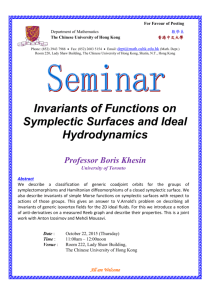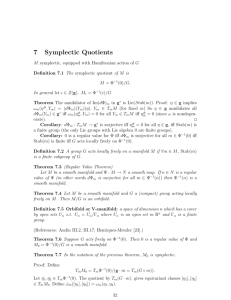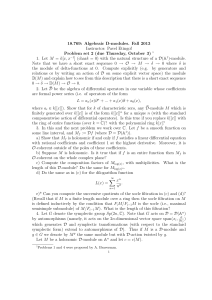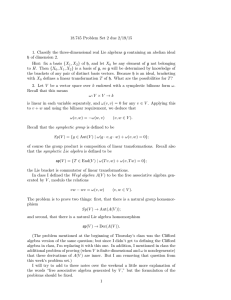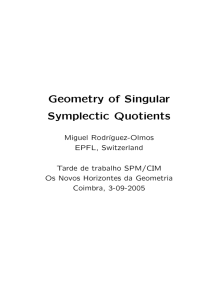M, ω WITH NO CIRCLE ACTION Jarek Kędra 1. Introduction
advertisement
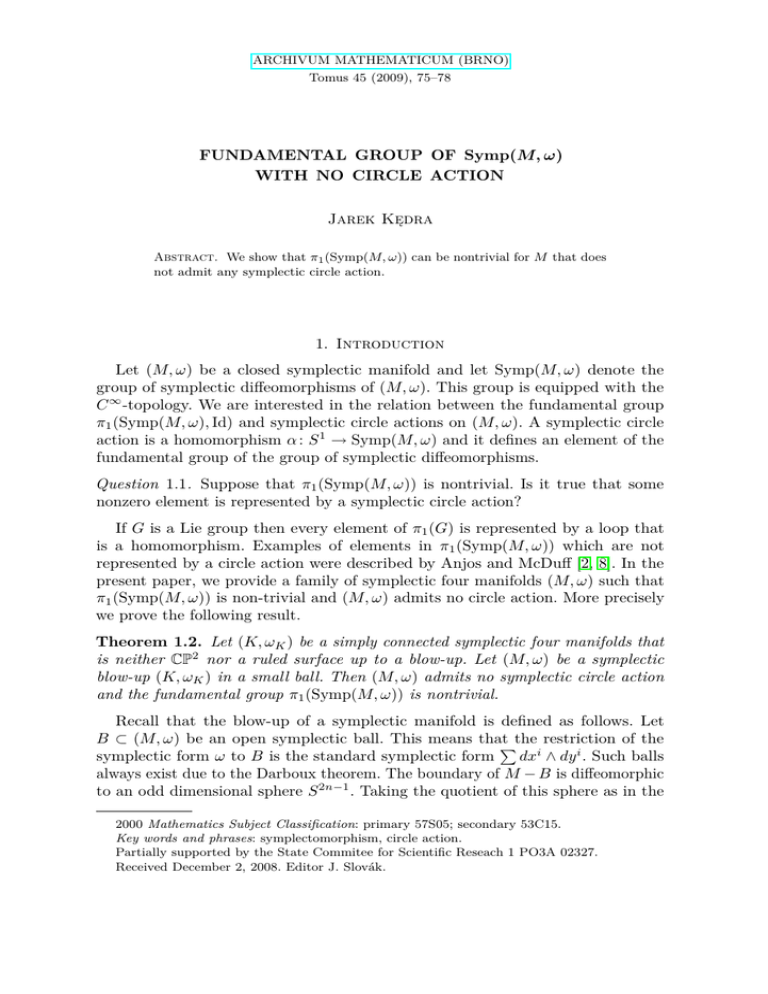
ARCHIVUM MATHEMATICUM (BRNO) Tomus 45 (2009), 75–78 FUNDAMENTAL GROUP OF Symp(M, ω) WITH NO CIRCLE ACTION Jarek Kędra Abstract. We show that π1 (Symp(M, ω)) can be nontrivial for M that does not admit any symplectic circle action. 1. Introduction Let (M, ω) be a closed symplectic manifold and let Symp(M, ω) denote the group of symplectic diffeomorphisms of (M, ω). This group is equipped with the C ∞ -topology. We are interested in the relation between the fundamental group π1 (Symp(M, ω), Id) and symplectic circle actions on (M, ω). A symplectic circle action is a homomorphism α : S 1 → Symp(M, ω) and it defines an element of the fundamental group of the group of symplectic diffeomorphisms. Question 1.1. Suppose that π1 (Symp(M, ω)) is nontrivial. Is it true that some nonzero element is represented by a symplectic circle action? If G is a Lie group then every element of π1 (G) is represented by a loop that is a homomorphism. Examples of elements in π1 (Symp(M, ω)) which are not represented by a circle action were described by Anjos and McDuff [2, 8]. In the present paper, we provide a family of symplectic four manifolds (M, ω) such that π1 (Symp(M, ω)) is non-trivial and (M, ω) admits no circle action. More precisely we prove the following result. Theorem 1.2. Let (K, ωK ) be a simply connected symplectic four manifolds that is neither CP2 nor a ruled surface up to a blow-up. Let (M, ω) be a symplectic blow-up (K, ωK ) in a small ball. Then (M, ω) admits no symplectic circle action and the fundamental group π1 (Symp(M, ω)) is nontrivial. Recall that the blow-up of a symplectic manifold is defined as follows. Let B ⊂ (M, ω) be an open symplectic ball. This means that of the Pthei restriction symplectic form ω to B is the standard symplectic form dx ∧ dy i . Such balls always exist due to the Darboux theorem. The boundary of M − B is diffeomorphic to an odd dimensional sphere S 2n−1 . Taking the quotient of this sphere as in the 2000 Mathematics Subject Classification: primary 57S05; secondary 53C15. Key words and phrases: symplectomorphism, circle action. Partially supported by the State Commitee for Scientific Reseach 1 PO3A 02327. Received December 2, 2008. Editor J. Slovák. 76 J. KĘDRA Hopf fibration S 2n−1 → CPn−1 we obtain a closed symplectic manifold called the blow-up of (M, ω) in a ball B (see Section 7.1 in [10] for details). The blow-up contains CPn−1 as a symplectic submanifold. It is called the exceptional divisor. Acknowledgement. I was asked Question 1.1. by Yael Karshon. The argument relies on a work of Lalonde and Pinsonnault [7]. I thank Yael Karshon, Dusa McDuff and Rafał Walczak for useful comments. 2. Proof of Theorem 1.2 There are very few manifolds admitting a circle action. On the other hand, the topology of groups of symplectic diffeomorphisms is rather complicated [6]. Hence one can expect nontrivial fundamental groups. The argument consists of several steps: Step 1: Take a closed simply connected symplectic manifold (K, ωK ). Choose a point p ∈ M and consider the evaluation fibration ev Symp(K, p) → Symp0 (K) → K, defined by ev(f ) := f (p). Here Symp(K, p) ⊂ Symp0 (K) denote the isotropy subgroup and Symp0 (K) denotes the identity component of the group of symplectic diffeomorphisms. We claim that the rank of π1 (Symp(K, p)) is positive. Observe that ev∗ : π2 (Symp(K)) → π2 (K) is trivial up to torsion. Indeed, if ev∗ (σ) were nontorsion then the corresponding map on rational cohomology would be nonzero, say ev ∗ (α) 6= 0 for α ∈ H 2 (K, Q) such that hα, σi = 6 0. Then we would have that 0 = ev ∗ (αn+1 ) = ev ∗ (α)n+1 , where dim K = 2n. But Symp(K) is a topological group so its rational cohomology is free graded algebra. Thus if ev ∗ (α)n+1 = 0 then ev ∗ (α) has to be a sum of products of degree one cohomology classes. Hence it has to vanish on spheres. On the other hand, hev ∗ (α), σi = hα, ev∗ (σ)i = 6 0 which is a contradiction. Finally, we get that the rank of π1 (Symp(K, p)) is not smaller than the rank of π2 (K). The latter is nonzero because because K is symplectic and simply connected. More precisely, since K is simply connected π2 (K) ∼ = H2 (M ; Z). The cohomology class of the symplectic form [ω] ∈ H 2 (M ; R) = Hom(H2 (M ; Z), R) is nonzero which proves that the rank of H2 (M ; Z) is nonzero which implies that the rank of π1 (Symp(K, p)) is positive as claimed. Step 2: The isotropy subgroup Symp(K, p) should be weakly homotopy equivalent to the group of symplectomorphisms of a one point blow-up of (K, ωK ) in a very small ball. This is proved for a range of 4-dimensional manifolds by Lalonde and Pinsonnault in [7] It is interesting to what extent it is true. Some progress has been made recently by McDuff [9]. More precisely, Lalonde and Pinsonnault proved (Lemma 2.3 and 2.4 in [7]) that, if for any almost complex structure J compatible with ω there exists unique FUNDAMENTAL GROUP OF Symp(M, ω) WITH NO CIRCLE ACTION 77 J-holomorphic sphere that is embedded then Symp(M, ω) is weakly homotopy equivalent to SympU (K, Bε ). The latter group is a subgroup of Symp(K, ωK ) which fixes a ball Bε ⊂ K and acts on it by unitary maps. Suppose that ωK is integral and ε is small enough. Then the exceptional divisor has unique J-holomorphic representative for any compatible J. It is easy to prove (Lemma 4.3 in [6]) that SympU (K, Bε ) is weakly homotopy equivalent to Symp(K, p). Step 3: The final step is to find a simply connected symplectic closed manifold that its blow-up does not admit any symplectic circle action. There is a classification, due to Audin [3] and Ahara-Hattori [1], of symplectic manifolds admitting a Hamiltonian circle action (see also Karshon [5]). In the simply connected case the symplectic action is Hamiltonian. According to this classification, a simply connected symplectic manifold admitting an effective circle action is a blow-up of the complex projective plane or a blow-up of a rational ruled surface. These are excluded by our hypothesis. This finishes the proof. 3. Remarks and examples 3.1. Let (M, ω) be as in the theorem and assume moreover that b+ 2 > 1. Due to a result of Baldridge [4], a simply connected 4-dimensional symplectic manifold with b+ 2 > 1 does not admit any smooth circle action. On the other hand, McDuff showed (Corollary 1.4 in [9]) that the fundamental group of Diff(M ) is non-trivial. Combining this two results with our proof we obtain examples of manifolds with nontrivial π1 (Diff(M )) and admitting no smooth circle actions. 3.2. Let K ⊂ CP3 be a hypersurface of degree d. It is simply connected according to the Lefschetz hyperplane theorem. Moreover, it is not difficult to calculate that 1 b+ 2 (K) = 1 + (d − 1)(d − 2)(d − 3) . 3 Hence every hypersurface of degree at least 4 satisfies the assumption of Theorem 1.2 and the above smooth analog. For d = 4 we obtain K3 surfaces. References [1] Ahara, K., Hattori, A., 4-dimensional symplectic S 1 -manifolds admitting moment map, J. Fac. Sci. Univ. Tokyo Sect. IA Math. 38 (2) (1991), 251–298. [2] Anjos, S., Homotopy type of symplectomorphism groups of S 2 × S 2 , Geom. Topol. 6 (2002), 195–218, (electronic). [3] Audin, M., Torus actions on symplectic manifolds, Progress in Mathematics, vol. 93, Birkhäuser Verlag, Basel, revised edition, 2004. [4] Baldridge, S., Seiberg-Witten vanishing theorem for S 1 -manifolds with fixed points, Pacific J. Math. 217 (1) (2004), 1–10. [5] Karshon, Y., Periodic Hamiltonian flows on four-dimensional manifolds, Mem. Amer. Math. Soc. 141 (672) (1999), viii+71. 78 J. KĘDRA [6] Kędra, J., Evaluation fibrations and topology of symplectomorphisms, Proc. Amer. Math. Soc. 133 (1) (2005), 305–312, (electronic). [7] Lalonde, F., Pinsonnault, M., The topology of the space of symplectic balls in rational 4-manifolds, Duke Math. J. 122 (2) (2004), 347–397. [8] McDuff, D., Symplectomorphism Groups and almost Complex Structures, In: Essays on geometry and related topics, Vol. 1, 2, 2001, volume 38 of Monogr. Enseign. Math., pp. 527–556. [9] McDuff, D., The symplectomorphism group of a blow up, Geom. Dedicata 132 (2008), 1–29. [10] McDuff, D., Salamon, D., Introduction to symplectic topology, Oxford Math. Monogr. (1998), Second edition. Mathematical Sciences, University of Aberdeen Meston Building, King’s College Aberdeen AB24 3UE, Scotland, UK E-mail: kedra@maths.abdn.ac.uk Institute of Mathematics, University of Szczecin Wielkopolska 15, 70-451 Szczecin, Poland
